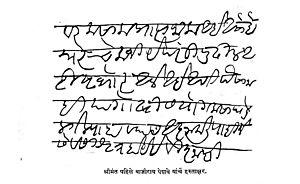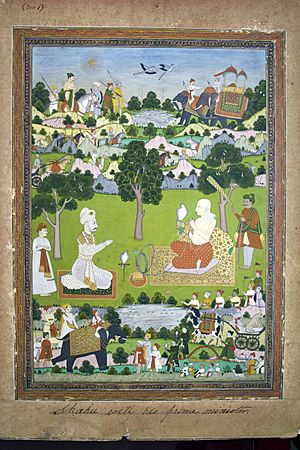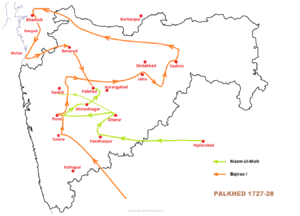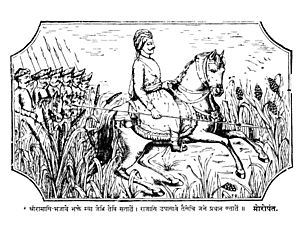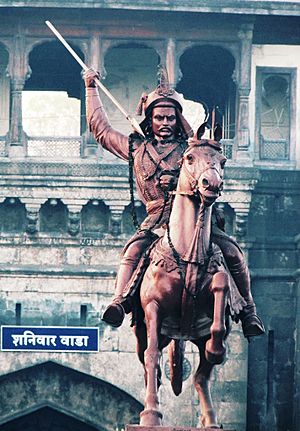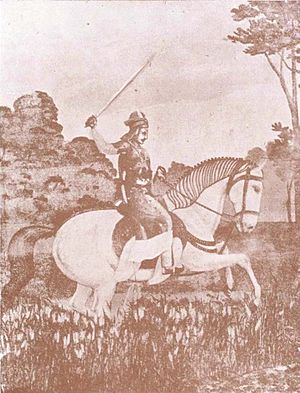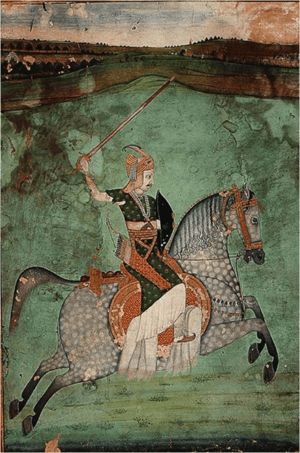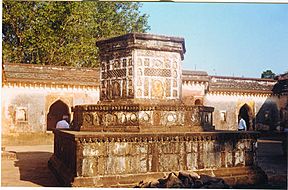Bajirao I facts for kids
Quick facts for kids
Bajirao I
|
|
|---|---|

Portrait of Bajirao I by an unknown artist.
|
|
| In office 17 April 1720 – 28 April 1740 |
|
| Monarch | Shahu I |
| Preceded by | Balaji Vishwanath |
| Succeeded by | Balaji Rao |
| Personal details | |
| Born |
Visaji Bhat
18 August 1700 Dubere, Sinnar, Maratha Empire (present-day Nashik, Maharashtra, India) |
| Died | 28 April 1740 (aged 39) Rawerkhedi, Maratha Confederacy (present-day Khargone district, Madhya Pradesh, India) |
| Spouses |
Kashibai
(m. 1720)Mastani
(m. 1728) |
| Relations |
|
| Children |
|
| Parents |
|
| Signature | |
Bajirao I (born Visaji; 18 August 1700 – 28 April 1740) was a very important leader in Indian history. He was the 7th Peshwa of the Maratha Confederacy. A Peshwa was like a prime minister or chief minister. During his 20 years as Peshwa, Bajirao I helped the Maratha Empire become very powerful.
He won many battles, like the Battle of Palkhed and Battle of Bhopal, against Nizam-ul-Mulk. Bajirao I helped the Marathas become the main power in both southern and northern India. He played a big part in spreading Maratha control to areas like Gujarat, Malwa, Rajputana, and Bundelkhand. He also helped free Konkan (on India's western coast) from the Siddis of Janjira and the Portuguese.
Bajirao I's life, especially his marriage to Mastani, has been shown in Indian books and movies.
Contents
Early Life of Bajirao I
Bajirao I was born into the Bhat family in Sinnar, near Nashik. His father, Balaji Vishwanath, was the Peshwa for Shahu Maharaj I. His mother was Radhabai Barve. Bajirao had a younger brother named Chimaji Appa and two younger sisters, Anubai and Bhiubai.
Bajirao spent his childhood in Saswad, a place his father had recently gained control of. He and his brother Chimaji were very close. Bajirao was inspired by famous Maratha leaders like Shivaji Maharaj, Ramchandra Pant Amatya, and Santaji Ghorpade.
Even though he came from a Brahmin family, which usually focused on studies like Sanskrit, Bajirao was also very interested in military matters from a young age. He often went with his father on army trips. He was with his father during an important trip to Delhi in 1719. On this trip, he became convinced that the Mughal Empire was getting weaker and that the Marathas could expand their power northwards. When his father, Balaji Vishwanath, passed away in 1720, Shahu Maharaj chose the 20-year-old Bajirao to be the new Peshwa. Some older leaders disagreed, but Shahu Maharaj trusted Bajirao.
Bajirao's Family Life
Bajirao's first wife was Kashibai. She was the daughter of a rich banking family from Chas. Bajirao always treated Kashibai with love and respect, and they had a happy relationship. They had four sons: Balaji Baji Rao (also known as Nanasaheb), Ramchandra Rao, Raghunath Rao, and Janardhan Rao. Janardhan Rao passed away at a young age. Nanasaheb later became Peshwa after his father in 1740.
Bajirao also married Mastani, who was the daughter of the Rajput king Chhatrasal and his Muslim wife. This marriage was a political arrangement to strengthen ties with Chhatrasal. Mastani had a son named Krishna Rao in 1734. Because his mother was Muslim, Hindu priests did not perform the traditional upanayana ceremony for him. He became known as Shamsher Bahadur. After Bajirao and Mastani died in 1740, Kashibai lovingly raised six-year-old Shamsher Bahadur as her own son. Shamsher received a part of his father's lands in Banda and Kalpi. In 1761, he and his army fought alongside the Peshwa in the Third Battle of Panipat against the Afghans. Shamsher was wounded in the battle and died a few days later.
In 1728, Bajirao moved his main base from Saswad to Pune. This helped Pune grow from a small town into a large city. He started building the Shaniwar Wada fortress in 1730, and it was finished in 1732. This marked the beginning of the Peshwas' strong control over the city.
Becoming the Peshwa
On April 17, 1720, Shahu Maharaj officially made Bajirao the Peshwa, taking over from his father. By this time, the Mughal emperor Muhammad Shah had agreed to the Maratha claims over the lands that Chhatrapati Shivaji Maharaj had controlled. A treaty also gave the Marathas the right to collect taxes, called chauth, from six provinces in the Deccan.
Bajirao convinced Shahu Maharaj that the Maratha Empire needed to attack its enemies to protect itself. He believed the Mughal Empire was falling apart and wanted to use this chance to expand Maratha power into North India. Bajirao famously compared the Mughals' declining power to a tree that would fall if attacked at its roots.
However, Bajirao faced challenges as a young Peshwa. His appointment made some older officials jealous. Bajirao chose to promote younger men like Malhar Rao Holkar, Ranoji Shinde, and the Pawar brothers as commanders. These men did not come from traditional powerful families. The Purandare family also played a big role in Bajirao's success.
The Mughal viceroy of the Deccan, Nizam-ul-Mulk Asaf Jah I, had created his own independent kingdom in the region. He challenged the Marathas' right to collect taxes. He claimed he didn't know if Shahu Maharaj or his cousin, Sambhaji Maharaj II of Kolhapur, was the true Maratha king. The Marathas also needed to show their power over new territories in Malwa and Gujarat. Some areas that were supposed to be Maratha, like the Janjira fort, were actually controlled by the Siddis.
Bajirao's Military Victories
Battling the Nizam
On January 4, 1721, Bajirao met Nizam-ul-Mulk Asaf Jah I to try and settle their disagreements. But the Nizam refused to let the Marathas collect taxes from the Deccan provinces. The Mughal emperor, worried about the Nizam's growing power, moved him from the Deccan in 1723. The Nizam rebelled and marched back to the Deccan. The emperor sent an army against him, but the Nizam won the Battle of Sakhar-kheda. This forced the emperor to accept him as the viceroy of the Deccan. Bajirao and the Marathas actually helped the Nizam win this battle. For his bravery, Bajirao received honors. However, the Nizam still wanted to create his own kingdom and saw the Marathas as rivals.
In 1725, the Nizam sent his army to remove Maratha tax collectors from the Carnatic region. The Marathas fought back but had to retreat. They tried again later but still couldn't stop the Nizam.
Meanwhile, Sambhaji Maharaj II of Kolhapur State claimed to be the true Maratha King, challenging Shahu Maharaj. The Nizam used this internal disagreement to his advantage, refusing to pay chauth because he said he didn't know who the real king was. Some Maratha leaders advised Shahu Maharaj to negotiate with the Nizam. But Bajirao convinced Shahu Maharaj to refuse the Nizam's offer and attack instead.
The Nizam then invaded Pune and put Sambhaji Maharaj II in charge there. He then left Pune, leaving some soldiers behind. The Nizam's army looted several towns. On August 27, 1727, Bajirao began a surprise guerrilla attack on the Nizam's forces. He destroyed towns controlled by the Nizam, crossed rivers, and plundered areas like Jalna and Sindkhed. Bajirao continued to devastate regions before heading towards Gujarat. When the Nizam heard that his northern lands were being destroyed, he left Pune to face Bajirao.
On February 25, 1728, Bajirao's and the Nizam's armies met at Palkhed, a town near Aurangabad. Bajirao's forces quickly surrounded the Nizam, cutting off his supplies and communication. The Nizam was forced to make peace. He signed the Treaty of Mungi Shevgaon on March 6, which recognized Shahu Maharaj as the true King and confirmed the Marathas' right to collect taxes in the Deccan. This battle is seen as a brilliant example of military strategy.
Conquering Malwa
In 1723, Bajirao had already sent an expedition to southern Malwa. Maratha chiefs like Ranoji Shinde and Malhar Rao Holkar had started collecting chauth from parts of the province. These chiefs later created their own kingdoms. To stop the Marathas, the Mughal emperor appointed Girdhar Bahadur as governor of Malwa.
After defeating the Nizam, Bajirao focused on Malwa again. In October 1728, he sent a large army led by his younger brother, Chimaji Appa, and generals Udaji Pawar and Malhar Rao Holkar. The Maratha army quickly moved north, crossing rivers and mountains. The Mughal forces, led by Girdhar Bahadur and his cousin Daya Bahadur, quickly prepared to fight them. In the Battle of Amjhera on November 29, 1728, Chimaji's army defeated the Mughals. Girdhar Bahadur and Daya Bahadur were killed. The Marathas took a lot of loot from the Mughal camp. By February 1729, Maratha forces had reached present-day Rajasthan.
Taking Bundelkhand
In Bundelkhand, Chhatrasal had rebelled against the Mughal Empire and formed his own kingdom. In December 1728, a Mughal force led by Muhammad Khan Bangash attacked him and surrounded his fort. Chhatrasal repeatedly asked Bajirao for help, comparing his desperate situation to a famous story.
In March 1729, Bajirao responded to Chhatrasal's request. He marched towards Bundelkhand with 25,000 horsemen and his trusted leaders. Chhatrasal escaped and joined the Maratha force, making their army 70,000 strong. Bajirao's forces surrounded Bangash, cutting off his supplies. Bangash tried to counterattack but couldn't break through. Bangash's son, Qaim Khan, arrived with fresh troops, but Bajirao's forces defeated him too. Bangash was forced to leave, signing an agreement that he would never attack Bundelkhand again. Chhatrasal was restored as the ruler of Bundelkhand. He gave a large area of land to Bajirao and also gave him his daughter Mastani in marriage. Before Chhatrasal's death in December 1731, he gave one-third of his lands to the Marathas.
Control over Gujarat
After making Maratha power strong in central India, Bajirao decided to claim the Maratha right to collect taxes from the rich province of Gujarat. In 1730, he sent a Maratha force under Chimaji Appa there. The Mughal governor of Gujarat, Sarbuland Khan, agreed to let the Marathas collect chauth. He was later replaced by Abhay Singh, who also recognized this right.
This angered Shahu's commander-in-chief, Trimbak Rao Dabhade. His family had often raided Gujarat and believed they had the right to collect taxes from there. Annoyed that Bajirao was taking control of what he saw as his family's area, Dabhade rebelled against the Peshwa. Two other Maratha nobles from Gujarat, Damaji Rao Gaekwad and Kadam Bande, also sided with Dabhade.
Bajirao learned that Dabhade and Gaikwad had prepared for a big fight at Dabhoi with 40,000 soldiers, while Bajirao had only 25,000. Bajirao repeatedly asked Dabhade to settle the dispute peacefully with Chatrapati Shahu Maharaj. But Dabhade refused. So, on April 1, 1731, Bajirao attacked the combined forces of Dabhade, Gaekwad, and Kadam Bande. During the battle, Trimbakrao was killed. Later, it was found that his own maternal uncle had fired the shot. Bajirao then settled the dispute with Sambhaji Maharaj II on April 13 by signing the Treaty of Warna, which clearly defined the territories of Shahu Maharaj and Sambhaji Maharaj II. The Nizam met Bajirao in December 1732 and promised not to interfere with Maratha expeditions.
Shahu Maharaj and Bajirao avoided a long rivalry with the powerful Dabhade family. Trimbak's son, Yashwant Rao, was appointed as Shahu Maharaj's commander-in-chief. The Dabhade family was allowed to continue collecting chauth from Gujarat, as long as they gave half the money to Shahu Maharaj's treasury.
Fighting the Siddis
The Siddis of Janjira controlled a small but important area on India's west coast. After Shivaji Maharaj's death, they expanded their rule. When the Siddi chief Yakut Khan died in 1733, his sons fought over who would rule next. One son, Abdul Rehman, asked Bajirao for help. Bajirao sent a Maratha force. The Marathas took back several parts of Konkan and surrounded Janjira. However, their efforts were split when another Maratha leader took over Raigad Fort in June 1733. The Maratha commander died in August, weakening their position. Bajirao then signed a peace treaty with the Siddis. They were allowed to keep Janjira if they accepted Abdul Rehman as their ruler. The Marathas kept Raigad and some other areas.
Soon after Bajirao returned to Satara, the Siddis tried to take back their lost lands. Bajirao sent forces to stop them from taking Raigad Fort in June 1734. Chimnaji made a surprise attack on a Siddi camp in April 1736, killing about 1,500 Siddis. In June 1736, Bajirao sent another force to gain control of areas like Gowalkot. On September 25 of that year, the Siddis signed another peace treaty. This treaty limited them to Janjira, Gowalkot, and Anjanvel.
Rajputana Relations
With Shahu Maharaj's permission, Bajirao began a journey north on October 9, 1735. He was joined by his wife, Kashibai. His goal was to visit the Rajput courts and convince them to pay chauth. Bajirao arrived at the southern border of Mewar in January 1736, where Rana Jagat Singh II had prepared for his visit.
They held diplomatic talks. Bajirao also visited the Jagmandir Palace and the Nath-Dwara. After settling matters in Mewar, Bajirao moved towards Jaipur. Jai Singh quickly came south with his forces, and they met near Kishangarh.
Their meeting lasted several days, discussing chauth and the transfer of Malwa from the Mughal Emperor. Bajirao then returned to the Deccan. However, the emperor did not agree to his demands, so Bajirao planned to march on Delhi to force him to agree.
Marching to Delhi
After Trimbak Rao's death, the alliance against the Marathas fell apart. The Mughal emperor called back Bangash from Malwa and re-appointed Jai Singh II as governor. However, the Maratha chief Holkar defeated Jai Singh in the 1733 Battle of Mandsaur. After two more battles, the Mughals offered the Marathas the right to collect 2.2 million lakh in chauth from Malwa. On March 4, 1736, Bajirao and Jai Singh reached an agreement. Jai Singh convinced the emperor to agree, and Bajirao was made deputy governor of the region. Jai Singh is believed to have secretly told Bajirao that it was a good time to challenge the weakening Mughal emperor.
Bajirao began his march on the Mughal capital, Delhi, from Pune on November 12, 1736, with 50,000 cavalry soldiers. When the Mughal emperor heard about the approaching Maratha army, he asked Saadat Ali Khan I to march from Agra and stop them. Maratha chiefs plundered Mughal territories. Saadat Khan led a force of 150,000, defeated them, and went to Mathura. Malhar Rao Holkar rejoined Bajirao's army near Gwalior. Mughal commanders thought the Marathas had retreated. But they soon learned that Bajirao had secretly taken a different route, avoiding the direct Agra-Delhi road, and was already near Delhi. The Mughal commanders rushed back to the capital. The Mughal emperor sent a force to stop Bajirao, but the Marathas defeated them in the Battle of Delhi on March 28, 1737. Bajirao then retreated from the capital, as a larger Mughal force was approaching from Mathura.
Bajirao's quick and bold move on Delhi was so surprising that neither the Mughal generals nor their spies could predict it.
The Battle of Bhopal
After Bajirao's march to Delhi, Mughal emperor Muhammad Shah asked the Nizam for help. The Nizam left the Deccan and met Bajirao's returning force. The Nizam was joined by other Mughal chiefs, and a 30,000-man Mughal army with artillery was sent against Bajirao. The Peshwa gathered an 80,000-man force. To stop the Nizam from getting help from the Deccan, Bajirao placed 10,000 soldiers under Chimaji Appa on the Tapti River.
Bajirao and his forces crossed the Narmada in early December 1737, using spies to watch enemy movements. The Nizam took shelter in Bhopal, a fortified town with a lake behind it, to keep his army and artillery safe.
Bajirao surrounded the Nizam, cutting off his supplies. Because of the Nizam's artillery, the Marathas kept their distance but constantly attacked his supply lines. No food could reach the Nizam's army, and his men and animals began to starve. The Nizam could not hold out any longer and signed a peace agreement at Doraha on January 7, 1738. Malwa was given to the Marathas. The Mughals agreed to pay 5 million rupees in war payments, and the Nizam swore on the Quran to follow the treaty.
Conflict with the Portuguese
The Portuguese had colonized several areas on India's west coast. They broke an agreement to give the Marathas a site for a factory on Salsette Island and were not tolerant of Hindus in their territory. In March 1737, the Peshwa sent a Maratha force led by Chimaji against them. The Marathas captured Ghodbunder Fort and almost all of Vasai in the Battle of Vasai. They gained control of Salsette on May 16, 1739, after a long siege. However, Nader Shah's invasion of India then shifted their attention away from the Portuguese. The war trophies from Vasai included several Church bells, which can now be found in many important Hindu temples in Maharashtra.
Bajirao's Battle Tactics and Character
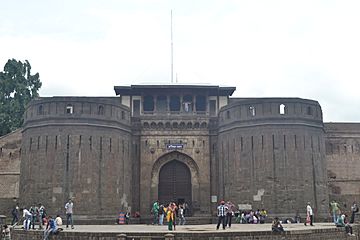
Bajirao I was famous for his fast and clever movements in battle. He used cavalry (soldiers on horseback) tactics that he learned from earlier Maratha generals. Two great examples are the Battle of Palkhed in 1728, where he outsmarted the Mughal governor, and the battle at Delhi in 1737. His special skill was moving large numbers of cavalry very quickly.
British field marshal Bernard Montgomery studied Bajirao's tactics in the Palkhed campaign. He noted Bajirao's rapid movements and his troops' ability to live off the land without worrying much about supplies. This allowed them to perform "maneuver warfare" against the enemy. Montgomery wrote that Bajirao's victory at Palkhed was a classic example of what skilled cavalry, led by a genius, could achieve.
Bajirao used the local land to cut off enemy supply lines. He led from the front, using traditional Maratha tactics: quickly surrounding the enemy, appearing from unexpected directions, distracting them, keeping them off-balance, and fighting on his own terms. Bajirao kept detailed information about enemy forces to himself, attacking where least expected, which made his enemies fearful.
Many historians consider Bajirao I to be one of the most celebrated figures in the history of the Maratha Empire. He is also seen as one of the greatest military generals of his time. Historian Jadunath Sarkar called Bajirao "a heavenly-born cavalry leader." He also wrote about Bajirao's twenty-year military career:
Chatrapati Shahu Maharaj had great faith in Bajirao. He ordered that "all should obey Baji Rao faithfully and should do nothing to offend his temper." On another occasion, he called Bajirao "the man with iron nerves."
Death of Bajirao I
Bajirao I's body was worn out from constant wars and military campaigns. He caught a severe fever while camped in Raverkhedi and passed away on April 28, 1740. He was cremated the same day on the bank of the Narmada River. His son, Balaji Baji Rao, ordered Ranoji Shinde to build a chhatri (a memorial structure) for him. The memorial is surrounded by a dharmashala (a resting place for travelers). The area also has two temples, dedicated to Nilkantheshwar Mahadev (Shiva) and Rameshwar (Rama).
Images for kids
-
March 31, 1739: Bajirao asks his brother Chimaji Appa to send more soldiers to Delhi to fight Nadir Shah.
See also
 In Spanish: Bajirao I para niños
In Spanish: Bajirao I para niños


